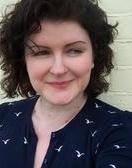Okay, so we have made it to day four of Blogvent and I've not gone mad yet. Today's subject was quite a challenge, but there are a number of color pictures, which makes a change. Say hello to Harriette Sutcliffe...
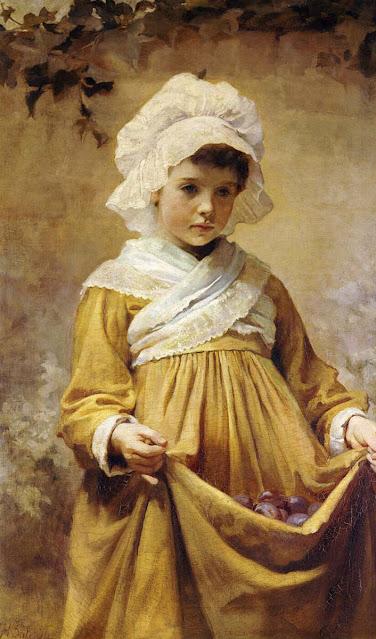
Gathering Plums (no date)
I hope you are braced for some extremely saccharine images of little poppets being delightful. If I was feeling a little kinder I would say that I am immediately reminded of Sophie Anderson's No Walk Today and some of Millais's more revolting kiddiewink pics. However, I am absolutely besotted with one of her paintings and so I had to bring her in to Blogvent. Let's start with her origins...

The Toy Horse (1900)
Harriette Frances Archer Sutcliffe was born on 20th September 1852 at St Pancras in London to John and Harriet. Being named after her mother, Harriette junior was known to the family (and the census taker) as 'Fanny' which puzzled me for a bit. John Sutcliffe was an artist and lithographer (or possibly a lithographic artist, which is something else entirely). Harriette was the third of four children, with elder sister Elizabeth, elder brother John and younger brother Henry Jules. It seems likely that John and Harriet senior met in Scotland, as Elizabeth and John junior were born there but by the 1851 census, the Sutcliffes were based in London. From what I can see, John junior joined the Royal Navy, dying at sea in the 1880s and Henry became a lithographic artist like his father. Elizabeth married 'paper stainer' (anything that involves colouring paper such as wallpaper) Frederic Aumonier. After her mother's death in 1880, Harriette remained at home with her father, both of them artists together.

The Young Sailor (1890)
Harriette's Royal Academy career began after attending the RA school in 1882. Her first piece was a portrait bust in 1881, where her address is given as 3 Christchurch Road, Hampstead. She doesn't exhibit again until 1885, when she showed Spring. She also appeared in Lets's Christmas Album of that year with two color plates, Feeding the Hungry and Going Ta-Ta (your guess is as good as mine). This was followed the year later by "Something the Heart must have to Cherish", which is an intriguing title, as is 1887's offering "Do Take It." By this point, Harriette and her father had moved to Johnson's Court, Fleet Street.
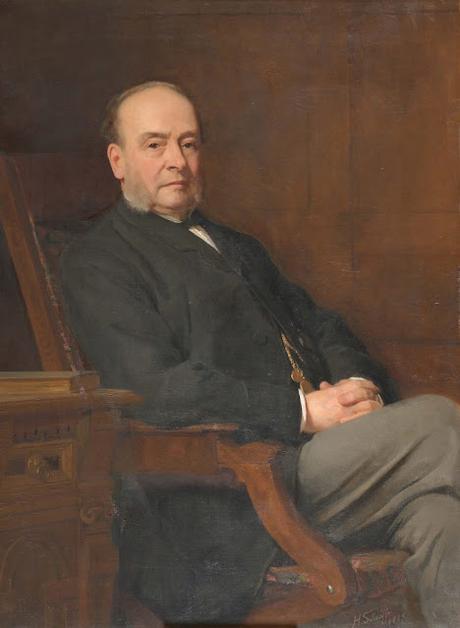
Sir Francis Roxburgh (1888)
Her next RA piece was Sir Francis Roxburgh, a QC from the Middle Temple and had been Treasurer in 1882. It is a very good portrait which leads me to wonder why she did not do more, or (if it wasn't her cup of tea to do portraits) why do it in the first place? She also did Mrs Grant in 1889 but they are the only non-poppet-y works she seems to have done. Maybe they were family friends? Maybe she needed some money and portraits were a very secure way of getting it? Interestingly, she also returned to school in Glasgow, possibly traveling with her father back to his homeland. It was reported in the Glasgow Herald that Harriette gained a bronze medal for drawing from the nude and also a prize for another drawing of a similar study at the Birbeck School under the instruction of Alfred Mason. All this led to her big break in 1891...
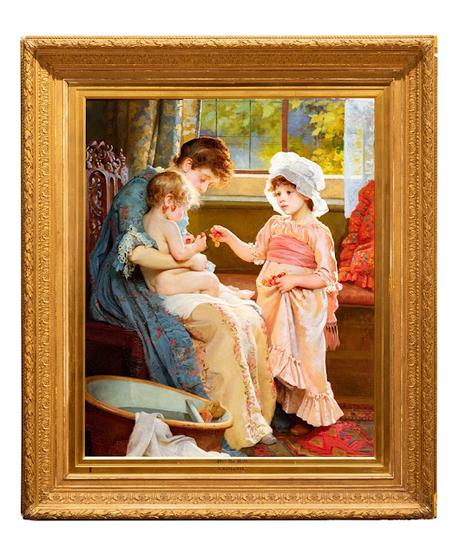
After the Bath (1891)
1891 was a turning point for Harriette and After the Bath was the painting that seems to have rocketed her to the public attention. The Queen magazine reported 'A young artist who is making long strides to the front, and, if she continues improving as she has done, will soon be in the very first rank with her sisterhood, is Harriette Sutcliffe, whose "After the Bath," a mother with child upon her lap, was sweet in the sentiment of maternity.' The Runcorn Guardian went into raptures over the piece - '"After the Bath" ... is a work of singular merit. It is most natural and easy, the nude child is exquisite, and its companion little less so, whilst the mother is the perfection of simple elegance. The lighting of the whole is sweetly translucent investing the picture with an attractive gaiety that eclipses its defects.'
Sadly, John did not live long to enjoy his daughter's success, dying in 1892. He left his money to Elizabeth but Harriette seems to have moved in with her sister and Mr Aumonier at Russell House in Hampstead, remaining an on-and-off part of their household probably until her sister died in the 1920s. Carrying on with Harriette's career, in 1893 she exhibited His First Lesson which I wonder is the same as His First Music Lesson, which appeared in the Christmas number of the St James' Budget...
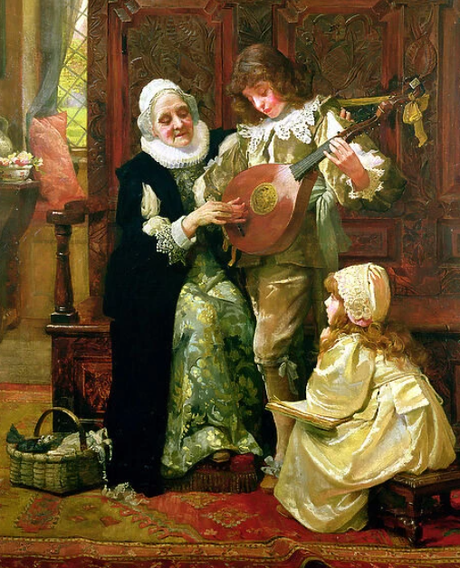
His First Music Lesson (1893?)
In 1894, she exhibited A New Book, which according to the Cheltenham Examiner 'justifies its name in the absorption of the girl reader, as she holds the prize before her eager eyes.' Possibly my least/most favorite (due to its revoltingness) has to be 1895's Rosy as a Pippin...
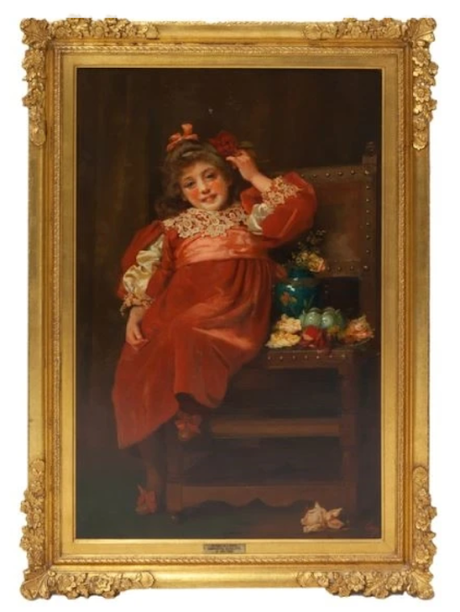
Rosy as a Pippin (1895)
Flipping heck, that is red. There was a bit of controversy surrounding this russet extravaganza, as reported in The Queen magazine 'Miss Harriette Sutcliffe's pictures have, ere now, deservedly found better places in the Academy Exhibition than that allotted to her bright study of a little girl "Rosy as a Pippin" which is both cornered and skied.' Quite honestly it could not be hung high enough as that is such a red picture. 1895 also saw Harriette exhibit at her local society in Hampstead, as reported in the Hampstead and Highgate Express '"Come Along" - a baby toddling towards its mother, is a very pleasing picture, the figures being remarkably good.'
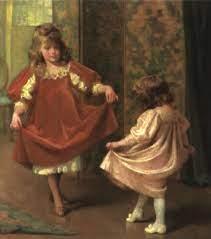
Her First Steps (undated)
There was no picture for 1896 (possibly people needed a year to get over Rosy as a Pippin) but she was back in 1897 with Look! - I would love to know what exactly this looked like - who is being told to look and at what? Likewise, I would dearly love to see "Keekie Boo!" of 1898. All I know of Look! is the Birmingham Mail's comments that it was purchased by the Art Union Committee as the first prize at the Birmingham Royal Society of Artists. It was described as 'a capital piece of painting, careful in treatment and natural in surroundings.' In 1899 came my very favorite of Harriette's pictures...
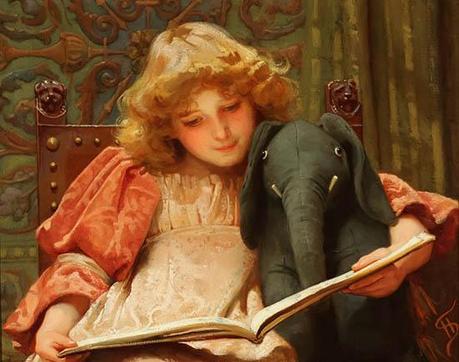
Beauty and the Beast (1899)
1899 was a cracking year for Harriette as she had three paintings in the Royal Academy - Honesty (a painting of a child holding a big bunch of Honesty), "Mother's Coming" and Beauty and the Beast, which has to be one of the cutest pictures I've ever seen. I think the realistically lumpy elephant, which is so unexpected, elevates this image and also makes it somewhat disconcerting. I am reminded of this absolute gem by George Dunlop Leslie...
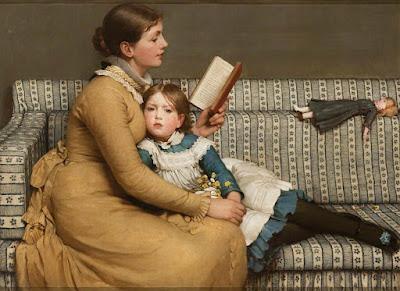
Alice in Wonderland (1879) George Dunlop Leslie
I think it is that the elephant is looking at us (like the child in Leslie's piece) which is a little uncomfortable. What is she reading to her elephant? That is a brilliant toy elephant - does it hold hints of Empire and the unknown East? I find it an unexpectedly intriguing piece because that elephant is just so big and modern looking; it's like he's appeared from someone else's painting.
After 1900, Harriette starts to fade from view. I suppose in a way it is unsurprising as her genre of art isn't strikingly modernist. She had a sort of side hustle with her images appearing in children's annuals, so I can imagine that carried on for a while, including Beauty and the Beast appearing in a children's annual in 1901 and her illustrations appearing beside Louis Wain's pictures of kittens in The Child's Companion book of 1898. She appeared at the Royal Academy a couple of times in the 1900s, in 1905 with The Thorn and 1907 with Comforter. In 1911, she is listed in the census as staying with her sister's family in Wealdstone and her occupation is 'Painter - Artist' (marvellous). I was utterly delighted to see that in the 1939 register she is living in Harrow and her occupation is 'Artist (retired)'. Admitting you are an artist is the first step, Harriette...
Harriette died in 1942, with seemingly no notice in the paper (or probate, that I have found so far). There has to be an exhibition in those outrageous kiddiewink pictures of the later Victorian period because they are so marvelous and atrocious at the same time. I'm willing to start a petition if necessary. Somehow, the thought that Beauty and the Beast is not in a national collection seems shocking as it really ought to be.
However, I can probably live with never seeing Rosy as a Pippin again...
